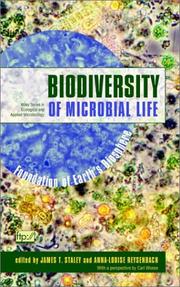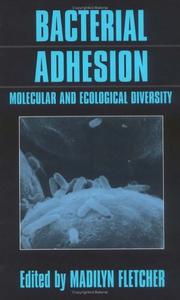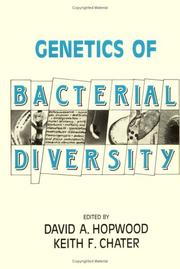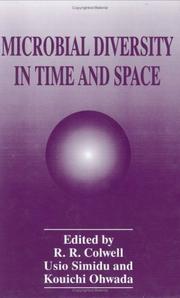| Listing 1 - 10 of 17 | << page >> |
Sort by
|
Book
ISBN: 0306448327 Year: 1994 Publisher: New York (N.Y.) : Plenum press,
Abstract | Keywords | Export | Availability | Bookmark
 Loading...
Loading...Choose an application
- Reference Manager
- EndNote
- RefWorks (Direct export to RefWorks)

ISBN: 0471254339 9780471254331 Year: 2002 Publisher: New York: Wiley,
Abstract | Keywords | Export | Availability | Bookmark
 Loading...
Loading...Choose an application
- Reference Manager
- EndNote
- RefWorks (Direct export to RefWorks)
Biodiversity of Microbial Life places the importance and novelty of the diversity of the microbial world in perspective with the biodiversity of plants and animals. Microbial diversity has driven the evolution of all life on Earth as well as the nutrient cycles, which are key to the operation of the biosphere. Microorganisms live in all ecosystems, even extreme environments not habitable to other organisms. Noted experts including Carl Woese, the originator of the Tree of Life, and Rita Colwell, who is now Director of the National Science Foundation, offer their unique perspectives on the extent and importance of microbial biodiversity. Special emphasis is placed on: * Evolution, speciation, and contrasts between microbial biodiversity and plant and animal biodiversity * Physiological and metabolic diversity of microorganisms * Biodiversity of microbial life in terrestrial and marine environments * Symbioses between microorganisms and plants, insects, and humans * Extreme environments populated exclusively or primarily by microorganisms including thermal vents and hot springs, polar sea ice environments, and subterranean ecosystems * Microorganisms and biotechnology Biodiversity of Microbial Life is an essential resource for all biologists interested in biodiversity.
Bacterial diversity. --- Microbial ecology. --- Microorganisms --- Evolution. --- Microbial ecology --- Bacterial diversity

ISBN: 0471021857 Year: 1996 Publisher: New York (N.Y.) : Wiley,
Abstract | Keywords | Export | Availability | Bookmark
 Loading...
Loading...Choose an application
- Reference Manager
- EndNote
- RefWorks (Direct export to RefWorks)
BACTERIAL ADHESION Molecular and Ecological Diversity Edited by Madilyn FletcherOver the last twenty years, research has revealed the enormous complexity underlying the phenomenon of bacterial adhesion. The initial research goal was to understand the mechanism of attachment and its effects on the bacteria as well as the host. As research progressed, however, it became evident that many different attachment mechanisms exist. These diverse forms of adhesion are the results of numerous evolutionary pressures, and each may be part of a larger behavioral strategy.This comprehensive overview details how diversity in habitat and ecological requirements has led to enormous variety in adhesive cell components, underlying genetic determinants, and behavioral strategies. It presents the latest research on adhesion mechanisms and strategies found in diverse environments and microorganisms, including the new environment of biomaterials.Bacterial Adhesion: Molecular and Ecological Diversity examines adhesion as a strategy for nutrient access and as a phase in the complex behavior of life cycle processes. It covers the latest research and innovative approaches in the field, including:Conceptual advances in research on the adhesion of bacteria to oral surfacesEnhancing colonization in a fluctuating environmentThe cellulosome: a cell-surface organelle for the adhesion to and degradation of cellulosePseudomonas aeruginosa--versatile attachment mechanismsSensing, response, and adaptation to surfacesMyxococcus coadhesion and role in the life cycleEdited by a leading authority on bacterial adhesion and featuring contributions from the field's leading experts, this book speaks to researchers in all areas of microbiology, biotechnology, environmental technology, and environmental science, as well as urology, immunology, and infectious diseases.Bacterial Adhesion: Molecular and Ecological Diversity is the latest addition to the Wiley Series in Ecological and Applied Microbiology.
Bacteria --- Bacterial diversity. --- Molecular microbiology. --- Adhesion.
Book
ISSN: 0070217X ISBN: 1281231630 9786611231637 3540754180 3540754172 Year: 2008 Volume: 322 Publisher: Berlin : Springer,
Abstract | Keywords | Export | Availability | Bookmark
 Loading...
Loading...Choose an application
- Reference Manager
- EndNote
- RefWorks (Direct export to RefWorks)
Throughout the biological world, bacteria thrive predominantly in surface attached, matrix enclosed, multicellular communities or biofilms, as opposed to isolated planktonic cells. This choice of lifestyle is not trivial, as it involves major shifts in the use of genetic information and cellular energy, and has profound consequences for bacterial physiology and survival. Growth within a biofilm can thwart immune function and antibiotic therapy and thereby complicate the treatment of infectious diseases, especially chronic and foreign device-associated infections. Modern studies of many important biofilms have advanced well beyond the descriptive stage, and have begun to provide molecular details of the structural, biochemical and genetic processes that drive biofilm formation and its dispersion. There is much diversity in the details of biofilm development among various species, but there are also commonalities. In most species, environmental and nutritional conditions greatly influence biofilm development. Similar kinds of adhesive molecules often promote biofilm formation in diverse species. Signaling and regulatory processes that drive biofilm development are often conserved, especially among related bacteria. Knowledge of such processes holds great promise for efforts to control biofilm growth and combat biofilm-associated infections. This volume tends to focus on the biology of biofilms that affect human disease. It opens with chapters that provide the reader with current perspectives on biofilm development, physiology, environmental and regulatory effects, the role of quorum sensing, and resistance/phenotypic persistence to antimicrobial agents during biofilm growth. The next chapters are devoted to common problematic biofilms, those that colonize venous and urinary catheters. The final series of chapters examines biofilm formation by four species that are important pathogens and well studied models, one of which, Yersinia pestis, cleverly adopts a biofilm state of growth within its insect vector to promote disease transmission to mammalian hosts.
Biofilms. --- Bacteria. --- Bacterial diversity. --- Diversity, Bacterial --- Microbial diversity --- Germs --- Microbes --- Prokaryotes --- Microbial aggregation --- Microbial ecology

ISBN: 1283635739 9812811826 9789812811820 9810243081 9789810243081 Year: 2001 Publisher: Singapore New Jersey World Scientific
Abstract | Keywords | Export | Availability | Bookmark
 Loading...
Loading...Choose an application
- Reference Manager
- EndNote
- RefWorks (Direct export to RefWorks)
Diversity of microbial forms in nature allows the discovery of new microorganisms that produce different types of bioactive compounds including some which may have specific physiological effects in animals. Asian countries possess numerous pristine and exotic locations for the isolation of new species of microorganisms. Research activities in such sciences have only recently been embarked upon by microbiologists from Asian countries as collaborative ventures. The present volume describes the occurrence of diverse and new microorganisms isolated from different sites in countries in Asia. This b
Microorganisms --- Bacterial diversity --- Diversity, Bacterial --- Microbial diversity --- Germs --- Micro-organisms --- Microbes --- Microscopic organisms --- Organisms --- Microbiology

ISBN: 0123555752 0123555744 1299196403 0080984088 1322205019 1483273555 9780123555755 9780123555748 Year: 1989 Publisher: London : Academic Press,
Abstract | Keywords | Export | Availability | Bookmark
 Loading...
Loading...Choose an application
- Reference Manager
- EndNote
- RefWorks (Direct export to RefWorks)
Genetics, Microbial --- Bacterial diversity --- Genetic aspects --- Bacteria --- Génétique --- genetics --- Enzymes --- Variation génétique --- genetic variation --- Génétique des populations --- population genetics --- Genetic aspects. --- Genetics. --- Luminescence. --- Cells. --- Bacterial diversity - Genetic aspects --- Cells --- Nitrogen fixation, biological --- Photosynthesis --- Plant --- Virus, bacterial

ISBN: 0585340463 0306451948 Year: 1996 Publisher: New York, New York ; London : Plenum Press,
Abstract | Keywords | Export | Availability | Bookmark
 Loading...
Loading...Choose an application
- Reference Manager
- EndNote
- RefWorks (Direct export to RefWorks)
The symposium, "Microbial Diversity in Time and Space," was held in the Sanjo Conference Hall, University of Tokyo, Tokyo, Japan, October 24-26, 1994. The symposium was organized under the auspices of the Japanese Society of Microbial Ecology and co-sponsored by the International Union of Biological Sciences (IUBS), International Union of Microbiological Societies (IUMS), International Committee on Microbial Ecology (ICOME), and the Japanese Society of Ecology. The aim of the symposium was to stress the importance of the global role of microorganisms in developing and maintaining biodiversity. Twenty-four speakers from seven countries presented papers in the symposium and in the workshop, "Microbial Diversity and Cycling of Bioelements," that followed the symposium. Papers presented at the symposium are published in this proceedings. Discussions of the workshop, which were energetic and enthusiastic, are also summarized in this proceedings. The symposium provided an opportunity to address the role of microorganisms in global cycles and as the basic support ofbiodiversity on the planet. Previously unrecognized as both contributing to and sustaining biodiversity, microorganisms are now considered to be primary elements of, and a driving force in, biodiversity. Financial support was provided for the symposium by the CIBA GEIGY Foundation for the Promotion of Science, Naito Foundation, and the Uchida Foundation of the Ocean Research Institute, University of Tokyo. Support from these foundations is gratefully acknowledged. CONTENTS Microbial Biodiversity-Global Aspects ................................. 1 Rita R. Colwell 2. Importance of Community Relationships in Biodiversity ...................
Bacterial diversity --- Microbiology --- Biochemistry. --- Microbiology. --- Biotechnology. --- Ecology. --- Botany. --- Biochemistry, general. --- Medical Microbiology. --- Plant Sciences. --- Ecology . --- Medical microbiology. --- Plant science.
Book
ISBN: 3319246526 3319246542 Year: 2015 Publisher: Cham : Springer International Publishing : Imprint: Springer,
Abstract | Keywords | Export | Availability | Bookmark
 Loading...
Loading...Choose an application
- Reference Manager
- EndNote
- RefWorks (Direct export to RefWorks)
The interest in eco-friendly, sustainable and organic farming cater high yield and quality in sustainable agriculture so as to relieve food scarcity. The plant growth and health promoting bacteria (PGHPR) are able to produce phytohormones and biosurfactants as effector metabolites in plant- microbe interactions and phyto-stimulation for their exploitation in agro-ecosystem. Bacterial phytohormones and biosurfactants are vital for plant growth and development, trigger nutrient availability, root colonization and imparting protection from phytopathogens in rhizosphere. This volume entitled “Bacterial Metabolites in Sustainable Agroecosystem” depicts various aspects of bacterial metabolites overtook on quest of research and concept up-gradation that can build emerging paradigm of future “Green Revolution”.
Microbiology & Immunology --- Biology --- Health & Biological Sciences --- Bacterial diversity. --- Agricultural ecology. --- Metabolites. --- Secondary metabolites --- Agriculture --- Agroecology --- Diversity, Bacterial --- Ecology --- Life sciences. --- Microbiology. --- Agriculture. --- Plant biochemistry. --- Microbial ecology. --- Life Sciences. --- Microbial Ecology. --- Plant Biochemistry. --- Applied Microbiology. --- Permaculture --- Biomolecules --- Biological products --- Chemical ecology --- Microbial diversity --- Environmental aspects --- Biochemistry. --- Farming --- Husbandry --- Industrial arts --- Life sciences --- Food supply --- Land use, Rural --- Microbial biology --- Microorganisms --- Biological chemistry --- Chemical composition of organisms --- Organisms --- Physiological chemistry --- Chemistry --- Medical sciences --- Environmental microbiology --- Microbiology --- Composition --- Phytochemistry --- Plant biochemistry --- Plant chemistry --- Biochemistry --- Botany --- Phytochemicals --- Plant biochemical genetics
Book
Year: 2021 Publisher: Basel, Switzerland MDPI - Multidisciplinary Digital Publishing Institute
Abstract | Keywords | Export | Availability | Bookmark
 Loading...
Loading...Choose an application
- Reference Manager
- EndNote
- RefWorks (Direct export to RefWorks)
This book emphasizes that soil productivity is considered an important factor for the success of agricultural production. The microbial community’s composition and the diversity of agricultural soils primarily depend on management practices. Exogenous nutritional inputs are inevitable processes in crop production, which can change the structure of soil bacterial communities. The combined application of compost and inorganic fertilizers might be a good way to keep up with agricultural productivity while maintaining the environmental balance. Bacterial communities are also known to differ according to the plant genotypes and hosts. Plant genotypic differences do not always lead to significant differences in microbiomes in the rhizosphere. It was concluded that imaginative research should address the simulation of the soil microenvironment, so as to understand the factors that regulate microbial activities in micro-niches.
Research & information: general --- halophyte --- arbuscular mycorrhizal fungi --- plant growth promoting rhizobacteria --- morphological characteristics --- photosynthesis --- soil enzymes --- microbial interactions --- rhizosphere --- DNA --- proteins --- microbial diversity --- microbial activity --- acidic soil improvement --- liming --- microbial community --- plant residue incorporation --- soil enzyme activity --- subtropical orchard soil --- phosphorus-enriched rhizosphere soils --- phosphate --- phytoremediation --- bacterial communities --- high-throughput sequencing --- Orchidaceae --- soil --- bacteria --- fungi --- microbiome --- heavy metal --- NGS --- azo dye --- textile --- wastewater --- diversity --- xenobiotics --- pollutant --- Nitrogen deposition --- soil biodiversity --- urban --- 16S rRNA --- wild-simulated ginseng --- Panax ginseng C.A. Meyer --- soil bacterial community --- soil property --- correlation analysis --- agricultural practices --- cultivar --- grafting --- interaction rootstock scion --- plant performance --- rhizosphere bacteria --- taxonomic indicators --- viticulture --- long-term fertilization --- next-generation sequencing --- bacterial diversity --- plant growth --- soil microbial community --- environmental factors --- soil contamination --- culture-independent analysis --- halophyte --- arbuscular mycorrhizal fungi --- plant growth promoting rhizobacteria --- morphological characteristics --- photosynthesis --- soil enzymes --- microbial interactions --- rhizosphere --- DNA --- proteins --- microbial diversity --- microbial activity --- acidic soil improvement --- liming --- microbial community --- plant residue incorporation --- soil enzyme activity --- subtropical orchard soil --- phosphorus-enriched rhizosphere soils --- phosphate --- phytoremediation --- bacterial communities --- high-throughput sequencing --- Orchidaceae --- soil --- bacteria --- fungi --- microbiome --- heavy metal --- NGS --- azo dye --- textile --- wastewater --- diversity --- xenobiotics --- pollutant --- Nitrogen deposition --- soil biodiversity --- urban --- 16S rRNA --- wild-simulated ginseng --- Panax ginseng C.A. Meyer --- soil bacterial community --- soil property --- correlation analysis --- agricultural practices --- cultivar --- grafting --- interaction rootstock scion --- plant performance --- rhizosphere bacteria --- taxonomic indicators --- viticulture --- long-term fertilization --- next-generation sequencing --- bacterial diversity --- plant growth --- soil microbial community --- environmental factors --- soil contamination --- culture-independent analysis
Book
Year: 2021 Publisher: Basel, Switzerland MDPI - Multidisciplinary Digital Publishing Institute
Abstract | Keywords | Export | Availability | Bookmark
 Loading...
Loading...Choose an application
- Reference Manager
- EndNote
- RefWorks (Direct export to RefWorks)
This book emphasizes that soil productivity is considered an important factor for the success of agricultural production. The microbial community’s composition and the diversity of agricultural soils primarily depend on management practices. Exogenous nutritional inputs are inevitable processes in crop production, which can change the structure of soil bacterial communities. The combined application of compost and inorganic fertilizers might be a good way to keep up with agricultural productivity while maintaining the environmental balance. Bacterial communities are also known to differ according to the plant genotypes and hosts. Plant genotypic differences do not always lead to significant differences in microbiomes in the rhizosphere. It was concluded that imaginative research should address the simulation of the soil microenvironment, so as to understand the factors that regulate microbial activities in micro-niches.
Research & information: general --- halophyte --- arbuscular mycorrhizal fungi --- plant growth promoting rhizobacteria --- morphological characteristics --- photosynthesis --- soil enzymes --- microbial interactions --- rhizosphere --- DNA --- proteins --- microbial diversity --- microbial activity --- acidic soil improvement --- liming --- microbial community --- plant residue incorporation --- soil enzyme activity --- subtropical orchard soil --- phosphorus-enriched rhizosphere soils --- phosphate --- phytoremediation --- bacterial communities --- high-throughput sequencing --- Orchidaceae --- soil --- bacteria --- fungi --- microbiome --- heavy metal --- NGS --- azo dye --- textile --- wastewater --- diversity --- xenobiotics --- pollutant --- Nitrogen deposition --- soil biodiversity --- urban --- 16S rRNA --- wild-simulated ginseng --- Panax ginseng C.A. Meyer --- soil bacterial community --- soil property --- correlation analysis --- agricultural practices --- cultivar --- grafting --- interaction rootstock scion --- plant performance --- rhizosphere bacteria --- taxonomic indicators --- viticulture --- long-term fertilization --- next-generation sequencing --- bacterial diversity --- plant growth --- soil microbial community --- environmental factors --- soil contamination --- culture-independent analysis
| Listing 1 - 10 of 17 | << page >> |
Sort by
|

 Search
Search Feedback
Feedback About UniCat
About UniCat  Help
Help News
News